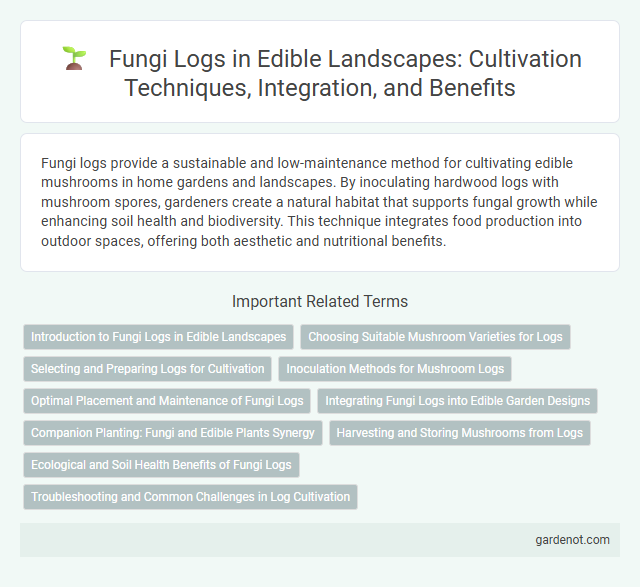Fungi logs provide a sustainable and low-maintenance method for cultivating edible mushrooms in home gardens and landscapes. By inoculating hardwood logs with mushroom spores, gardeners create a natural habitat that supports fungal growth while enhancing soil health and biodiversity. This technique integrates food production into outdoor spaces, offering both aesthetic and nutritional benefits.
Introduction to Fungi Logs in Edible Landscapes
Fungi logs serve as an innovative component in edible landscapes by cultivating mushrooms directly on decomposing wood, enhancing biodiversity and soil health. These logs, often inoculated with species like shiitake or oyster mushrooms, transform dormant tree trunks into sustainable food sources. Integrating fungi logs promotes nutrient cycling and provides an eco-friendly harvest of gourmet mushrooms within garden ecosystems.
Choosing Suitable Mushroom Varieties for Logs
Selecting mushroom varieties for fungi logs requires considering the local climate, log type, and desired harvest frequency. Popular species such as shiitake (Lentinula edodes) thrive on hardwood logs like oak and maple, while oyster mushrooms (Pleurotus ostreatus) prefer softer woods and faster growth cycles. Matching mushroom varieties with appropriate wood enhances yield, pest resistance, and overall sustainability in an edible landscape.
Selecting and Preparing Logs for Cultivation
Selecting hardwood logs such as oak, beech, or maple with a diameter of 4 to 8 inches and freshly cut within the last two weeks ensures optimal fungal colonization for edible mushroom cultivation. Preparing logs by cutting them into 3 to 4 feet lengths, drilling 3/8 -inch holes spaced 6 inches apart, and inoculating with quality spawn before sealing with wax maintains moisture and prevents contamination. Proper site selection with shade and moisture retention supports the mycelium's growth, resulting in a productive fungi log for an edible landscape.
Inoculation Methods for Mushroom Logs
Inoculation methods for mushroom logs primarily include plug spawn, sawdust spawn, and grain spawn, each offering specific benefits for fungal colonization efficiency. Plug spawn, consisting of wooden dowels inoculated with mycelium, is commonly driven into drilled holes in logs, ensuring direct mycelial contact with the wood substrate. Sawdust spawn allows uniform distribution by filling holes or layering on log surfaces, optimizing moisture and nutrient absorption for rapid fungal growth.
Optimal Placement and Maintenance of Fungi Logs
Fungi logs thrive in shaded, moist environments with consistent humidity, making north-facing areas under tree canopies ideal for optimal placement. Regularly monitor moisture levels and soak logs during dry periods to maintain fungal mycelium health and maximize mushroom yield. Avoid direct sunlight and air circulation that can dry out the logs, ensuring sustained fungal growth and productivity.
Integrating Fungi Logs into Edible Garden Designs
Fungi logs serve as a sustainable and productive element in edible garden designs by fostering the growth of nutrient-rich mushrooms such as shiitake and oyster varieties. Incorporating these logs enhances soil health through natural decomposition processes and supports biodiversity by creating microhabitats for beneficial organisms. Strategic placement of fungi logs within garden beds maximizes space utilization while contributing to a resilient and diverse edible landscape ecosystem.
Companion Planting: Fungi and Edible Plants Synergy
Fungi logs create a symbiotic environment that enhances companion planting by promoting nutrient exchange between mycelium and edible plants. This natural synergy boosts plant health, improves soil structure, and increases overall crop yield. Harnessing fungi's ability to decompose organic matter supports sustainable edible landscapes by nurturing robust companion planting ecosystems.
Harvesting and Storing Mushrooms from Logs
Harvest mushrooms from fungi logs when caps fully open but before spores release, ensuring optimal flavor and texture. Use a clean, sharp knife to cut mushrooms at the base without damaging the log surface, preserving future yields. Store harvested mushrooms in breathable containers like paper bags in a cool, dry environment to maintain freshness and prevent moisture buildup.
Ecological and Soil Health Benefits of Fungi Logs
Fungi logs enhance soil health by decomposing organic matter, releasing essential nutrients like nitrogen and phosphorus back into the ecosystem, which promotes robust plant growth in edible landscapes. Their mycelium networks improve soil structure, increase water retention, and support beneficial microbial diversity crucial for nutrient cycling. These ecological contributions foster sustainable gardening practices by naturally restoring soil fertility and reducing the need for synthetic fertilizers.
Troubleshooting and Common Challenges in Log Cultivation
Fungi log cultivation often faces challenges such as contamination by competing molds or bacteria, which can inhibit mushroom mycelium growth. Maintaining optimal moisture levels is crucial, as overly wet or dry logs create unfavorable conditions for fungal development and increase the risk of rot. Regular inspection for pests like slugs and insects helps prevent damage to the mycelium and ensures successful mushroom production.
Fungi log Infographic

 gardenot.com
gardenot.com